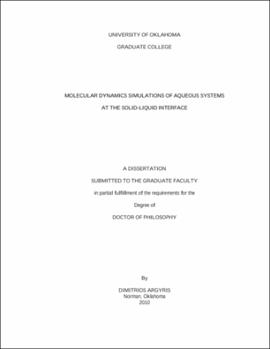| dc.description.abstract | Interfacial water properties determine a number of phenomena in geology, biological systems, and ion-exchange processes. The behavior of water at the solid-liquid interface plays an important role in multiple applications including water desalination membranes, porous materials used in radioactive ion separations, and in the structure-function relationship in ion channels and biological membranes. Understanding the properties of interfacial water is therefore essential for securing progress in all these areas. Molecular dynamics simulations were performed to provide molecular level insights of the structural and dynamic behavior of interfacial water near various solid substrates. Density profiles, radial distribution functions, and in-plane density distributions were calculated to study the effect of silica, alumina, and graphite surfaces on the structure of interfacial water. Our results show the formation of two distinct structured water layers with in-plane density distributions highly dependent on the surface chemistry of the substrate. Our findings suggest that due to the surface, the perturbation of the water structure decreases as the distance from the solid substrate increases, becoming a non-factor for distances greater than ~14 Å from the surface. The in-plane organization of water molecules in contact with the surface also locally affects the hydrogen bond network and consequently the dynamic behavior of interfacial water. The dynamic properties were assessed in terms of residence and reorientation correlation functions. An anisotropic dynamic reorientation was observed for water at the silica surface. Towards deploying experimental techniques to validate our predictions, massive molecular dynamics simulations were utilized to study hydration forces near alumina surfaces. A single-walled carbon nanotube (CNT) was employed to mimic an atomic force microscope (AFM) tip used in force spectroscopy. The results illustrate oscillatory hydration forces that act on the CNT at small separations. Changes on the local interfacial water density due to the presence of the CNT tip yield non-sinusoidal oscillations on the force profiles with a width of approximately the size of a water molecule. High local water density yields pronounced repulsive forces, while local density depletion yields attractive forces. Finally, we studied the behavior of aqueous electrolyte solutions in slit-shaped silica nanopores. The results support the existence of ion-specific effects under confinement, which can be explained by the properties of interfacial water. | |
